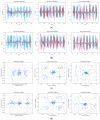Reconstruction of OFDM Signals Using a Dual Discriminator CGAN with BiLSTM and Transformer
- PMID: 39065962
- PMCID: PMC11280535
- DOI: 10.3390/s24144562
Reconstruction of OFDM Signals Using a Dual Discriminator CGAN with BiLSTM and Transformer
Abstract
Communication signal reconstruction technology represents a critical area of research within communication countermeasures and signal processing. Considering traditional OFDM signal reconstruction methods' intricacy and suboptimal reconstruction performance, a dual discriminator CGAN model incorporating LSTM and Transformer is proposed. When reconstructing OFDM signals using the traditional CNN network, it becomes challenging to extract intricate temporal information. Therefore, the BiLSTM network is incorporated into the first discriminator to capture timing details of the IQ (In-phase and Quadrature-phase) sequence and constellation map information of the AP (Amplitude and Phase) sequence. Subsequently, following the addition of fixed position coding, these data are fed into the core network constructed based on the Transformer Encoder for further learning. Simultaneously, to capture the correlation between the two IQ signals, the VIT (Vision in Transformer) concept is incorporated into the second discriminator. The IQ sequence is treated as a single-channel two-dimensional image and segmented into pixel blocks containing IQ sequence through Conv2d. Fixed position coding is added and sent to the Transformer core network for learning. The generator network transforms input noise data into a dimensional space aligned with the IQ signal and embedding vector dimensions. It appends identical position encoding information to the IQ sequence before sending it to the Transformer network. The experimental results demonstrate that, under commonly utilized OFDM modulation formats such as BPSK, QPSK, and 16QAM, the time series waveform, constellation diagram, and spectral diagram exhibit high-quality reconstruction. Our algorithm achieves improved signal quality while managing complexity compared to other reconstruction methods.
Keywords: LSTM; communication signal; conditional generative adversarial network; orthogonal frequency division multiplexing; signal reconstruction; transformer.
Conflict of interest statement
The authors declare no conflicts of interest.
Figures


















References
-
- Zhao F., Jin H. Communication jamming waveform generation technology based on GAN. Syst. Eng. Electron. 2021;43:1080–1088.
-
- Zhang J.Y., Li C., Yang Y. A Study on key techniques in cognitive communication countermeasures. Radio Eng. 2020;50:619–623.
-
- Gu Y., Xu S., Zhou J. Automatic Modulation Format Classification of USRP Transmitted Signals Based on SVM; Proceedings of the 2020 Chinese Automation Congress (CAC); Shanghai, China. 6–8 November 2020; pp. 3712–3717.
-
- Chai X. Master’s Thesis. Nanchang University; Nanchang, China: 2023. Research on Key Technology of Blind Demodulation for OFDM Signals.
LinkOut - more resources
Full Text Sources

